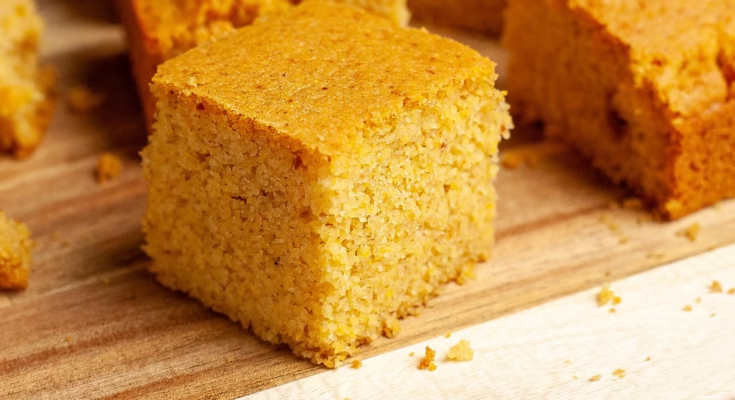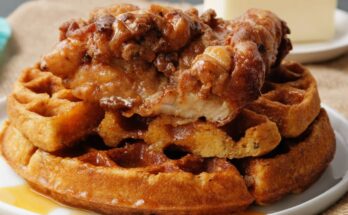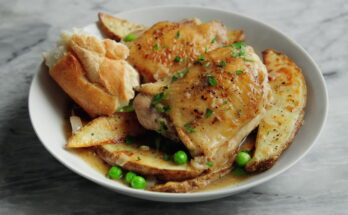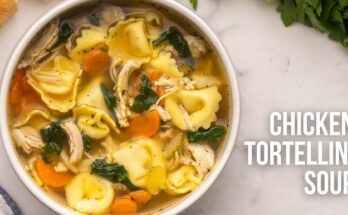Vegan Cornbread Recipe: Cornbread is a beloved comfort food known for its golden crust and fluffy interior. But what if you’re vegan or trying to cut down on animal products? Good news—you can still enjoy this Southern classic without eggs, milk, or butter. Vegan cornbread offers the same rich, hearty flavor and crumbly texture, just with a plant-based twist. Whether you’re pairing it with chili, enjoying it solo, or looking to make a healthier version, vegan cornbread hits the spot.
What Makes Cornbread Vegan?
Traditionally, cornbread includes dairy milk, eggs, and sometimes butter. To make it vegan, those ingredients are swapped with plant-based alternatives. Almond milk, soy milk, or oat milk can replace dairy milk, while flaxseed meal or applesauce can stand in for eggs. Vegan butter or coconut oil easily replaces regular butter. The result? A cruelty-free cornbread that’s just as moist and delicious.
Why Choose Vegan Cornbread?
You don’t need to be vegan to enjoy vegan cornbread. It’s a lighter, healthier option and ideal for people with dairy or egg allergies. Plus, plant-based recipes are more sustainable and often easier to digest. Whether you’re living a vegan lifestyle or simply experimenting with meatless meals, this cornbread fits into any menu perfectly.
Ingredients You’ll Need
Core Ingredients Breakdown
Here’s a simple list of the core ingredients you’ll need to whip up a mouthwatering vegan cornbread:
- 1 cup cornmeal (medium grind)
- 1 cup all-purpose flour (or gluten-free flour)
- 1 tbsp baking powder
- 1/2 tsp baking soda
- 1/2 tsp salt
- 1 cup unsweetened almond milk (or any plant milk)
- 1 tbsp apple cider vinegar
- 1/3 cup maple syrup or agave nectar
- 1/3 cup melted coconut oil or vegan butter
- 1/4 cup unsweetened applesauce (egg replacement)
Each of these ingredients plays a vital role—cornmeal gives that signature flavor and texture, while applesauce and maple syrup keep things moist and naturally sweet without added sugar.
Optional Add-ins and Variations
Want to make your cornbread extra special? Try these tasty variations:
- Add 1/2 cup of corn kernels for a more rustic texture
- Mix in chopped jalapeños for a spicy kick
- Stir in vegan shredded cheese for a cheesy twist
- Add herbs like rosemary or thyme for an aromatic touch
You can also experiment with different flours like spelt or oat for a denser or heartier bread.
Kitchen Tools Required
Essential Baking Equipment
To make your vegan cornbread, make sure you have the following:
- Large mixing bowls
- Measuring cups and spoons
- Whisk or mixing spoon
- 8×8 inch baking dish or cast-iron skillet
- Oven mitts
Helpful Tools for Efficiency
For extra convenience:
- A silicone spatula helps in mixing without scraping the bowl
- Parchment paper makes cleanup easier
- A cooling rack ensures the bread doesn’t get soggy underneath
Being well-prepared in your kitchen setup ensures a smooth and stress-free cooking experience.
Step-by-Step Instructions
Step 1: Preheat and Prepare
Start by preheating your oven to 375°F (190°C). Lightly grease your baking dish with a bit of coconut oil or vegan butter, or line it with parchment paper. This prevents sticking and helps you lift out the cornbread easily later.
Step 2: Mix Dry Ingredients
In a large mixing bowl, combine the cornmeal, flour, baking powder, baking soda, and salt. Stir well so everything is evenly distributed. This step is important to ensure your cornbread rises properly and has a consistent texture throughout.
Step 3: Combine Wet Ingredients
In a separate bowl, mix the almond milk and apple cider vinegar together. Let it sit for 2-3 minutes to curdle slightly—this acts like vegan buttermilk. Then add the maple syrup, melted coconut oil, and applesauce. Whisk everything until it’s fully blended.
Step 4: Blend Everything Together
Now slowly pour the wet mixture into the dry ingredients. Gently fold with a spatula or wooden spoon until just combined—don’t overmix! The batter should be thick but pourable.
Step 5: Pour and Bake
Pour the batter into your prepared baking dish and smooth out the top. Bake for 25-30 minutes, or until a toothpick inserted in the center comes out clean. Let the cornbread cool in the pan for at least 10 minutes before slicing.
Tips for Perfect Vegan Cornbread
Texture and Moisture Balance
The trick to moist vegan cornbread lies in the balance of wet and dry ingredients. Applesauce adds natural moisture without making it soggy. Coconut oil keeps the crumb tender. Don’t skip letting the “buttermilk” sit—this helps activate the baking soda for a fluffier texture.
Baking Time and Temperature Control
Avoid opening the oven frequently while baking. Use an oven thermometer if you’re unsure about your oven’s accuracy. If the top browns too quickly, cover it loosely with foil during the last 10 minutes.
Serving Suggestions for Vegan Cornbread
Best Dishes to Pair With Vegan Cornbread
One of the best things about cornbread is how versatile it is. It pairs perfectly with a wide variety of dishes. Here are a few favorite pairings:
- Vegan Chili – A classic combo. The sweet and savory notes of the cornbread balance the heat and heartiness of chili.
- Barbecue Dishes – Cornbread goes hand-in-hand with vegan BBQ tofu, seitan ribs, or grilled vegetables.
- Soups and Stews – Whether it’s a creamy potato soup or a chunky lentil stew, cornbread is the perfect sidekick.
- Salads – Believe it or not, a warm slice of cornbread with a crisp, tangy salad can be a light but satisfying meal.
Sweet vs. Savory Cornbread Options
Cornbread can swing both ways: sweet or savory. Sweet cornbread often includes maple syrup, agave, or even a bit of sugar. It’s great as a breakfast or dessert bread. You can top it with vegan butter, fruit compote, or nut butters.
Savory versions tend to be less sweet and include ingredients like chopped herbs, jalapeños, or dairy-free cheese. These are ideal for lunch and dinner sides. You can even cube savory cornbread and turn it into croutons for a salad.
Storing and Reheating Vegan Cornbread
How to Store Cornbread Properly
Vegan cornbread stores quite well if done right. Let it cool completely before storing to avoid trapping moisture, which can lead to sogginess or mold. You can store it:
- At room temperature for up to 2 days in an airtight container
- In the fridge for up to 5 days—wrap it tightly in foil or plastic wrap
- In the freezer for up to 2 months—cut into slices, wrap individually, and place in a freezer bag
Best Reheating Techniques
When you’re ready to eat, you can reheat it easily using several methods:
- Oven: Wrap in foil and bake at 300°F (150°C) for 10-15 minutes
- Microwave: Heat slices for about 20-30 seconds (cover with a damp paper towel for moisture)
- Toaster oven: A good option for crispy edges
Avoid over-reheating as it can dry out your bread. Adding a dab of vegan butter on top before reheating can help keep it moist.
Making Vegan Cornbread Gluten-Free
How to Substitute Gluten-Free Flour
If you’re gluten-intolerant or just trying to reduce gluten, it’s simple to adapt this recipe. You can swap the all-purpose flour with a 1:1 gluten-free baking blend. Make sure it contains xanthan gum, or add 1/4 tsp per cup if not. Other great gluten-free flour options include:
- Oat flour (for a denser, earthier texture)
- Almond flour (mix with other flours to keep structure)
- Buckwheat flour (for a rustic flavor)
Maintaining the Right Texture Without Gluten
Cornbread made with gluten-free flour may be a bit crumblier than traditional versions. To help with binding, you can add:
- Extra applesauce or mashed banana
- Flax eggs (1 tbsp flaxseed meal + 3 tbsp water = 1 egg)
- A tablespoon of ground chia seeds
These will give your gluten-free vegan cornbread the structure it needs while keeping it tender and flavorful.
Common Mistakes to Avoid
Overmixing the Batter
Mixing too vigorously or for too long is one of the most common baking mistakes. Overmixing activates gluten in the flour, even in small amounts, leading to dense, chewy bread instead of light and fluffy cornbread.
Using the Wrong Cornmeal
Always go for medium or fine-grind cornmeal. Coarse cornmeal can make the bread gritty, while corn flour will give it a cake-like texture. Also, make sure it’s plain cornmeal and not self-rising unless the recipe is adjusted accordingly.
Skipping the Resting Time
Letting the batter sit for 5 minutes before baking helps the cornmeal absorb the liquid, resulting in a more cohesive and flavorful bread. It also gives the leavening agents a head start, which improves the rise.
FAQs about Vegan Cornbread Recipe
1. Can I make vegan cornbread without oil?
Yes! You can substitute the oil with extra applesauce or mashed banana for a low-fat version. The texture might be slightly different, but it will still taste great.
2. What plant milk works best in vegan cornbread?
Almond milk is a popular choice, but oat, soy, and coconut milk all work well. Just make sure it’s unsweetened and unflavored for best results.
3. Can I turn this recipe into muffins?
Absolutely. Just pour the batter into a greased muffin tin and bake at 375°F for 15–20 minutes, or until a toothpick comes out clean.
4. How do I make this cornbread spicier?
Add finely chopped jalapeños, a pinch of cayenne pepper, or a bit of hot sauce to the batter for some heat.
5. Is this recipe good for meal prepping?
Yes, it stores and reheats well, so it’s great for batch cooking. Make a big batch, slice it up, and enjoy it throughout the week.
Conclusion
Vegan cornbread is a delicious, wholesome, and easy-to-make dish that belongs in every plant-based cook’s recipe box. With just a few simple ingredients and basic kitchen tools, you can whip up a comforting side that works with everything from stews to salads to barbecues. Whether you like it sweet or savory, this cornbread is a total crowd-pleaser—no eggs or dairy needed. Perfect for weeknights, potlucks, or holidays, this is one recipe you’ll return to time and time again.



